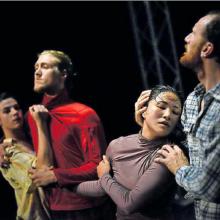It’s all a question of energy
It’s all a question of energy
Didier Théron thrills the Mannheim audience with his dance piece.

When a choreographer names Merce Cunningham, master of the avant-garde of contemporary dance, and a Japanese Zen master as his teachers, one can at least hope for an original artistic style. Didier Théron exceeds this expectation by far. Rarely does one experience such an original movement language, filling the entire stage using seemingly simple means.
Last year, Didier Théron’s choreography “Shanghai Boléro" was the surprise success of the Heidelberg Dance Biennale. Following this success, the Frenchman from Montpellier - Heidelberg's twin city - was immediately invited to perform another of his original pieces, this time for the opening of the Heidelberg French Week Festival. This second piece, “The Young Man and Death” (LJHELM - Le Jeune Homme et la Mort) was choreographed in 2014 to commemorate the outbreak of the First World War a hundred years earlier.
With his new choreography "Resurrection", which premiered at the EinTanzHaus stage in Mannheim, the choreographer recalls the end of this war.
Falling down, and standing up.
For Didier Théron, wars are never simply over, and certainly not this particular war. In his own family, he experienced how the memory of his great-grandfather, who fell in 1915, traumatized the following generations. In 2019 the motto is "Resurrection" - not from death, but from the ghosts of the past.
Didier Théron entrusts four very different protagonists with this task of resurrection: two men and two women dressed in unadorned everyday clothes. With seemingly simple movements he lets them find their way back to life. The musician François Richomme creates a soundscape based on the constant pulsating rhythm of the heartbeat, and brings it into the empty stage space.
However, the performance begins in silence with the feat of a synchronized dance, in which the four performers dance with movements reminiscent of a joint workout as if following silent orders. Apart from a few tiny exceptions, the choreography is solely composed with everyday movements and athletic exercises – but these are performed with concentrated power which keeps the stage and audience in suspense. Falling down - standing up : Again and again the dancers lie motionless on the ground; again and again they spring to new life. Didier Théron doesn't tell a story. He doesn't make any historical allusions nor does he provide any concrete content. What drives him and the dancers is the question of energy. And because Didier Théron doesn’t associate Christian hopes with the question of "resurrection", the strength for new life must come from the people themselves. That is the first and stirring message of this just under one-hour piece. The second message is the unconditional trust in the power of the community. Not once does a dancer perform a task or movement without relating to the others. The group functions like a net in which the dancers move to the rhythm of the heartbeat without ever sliding into a casual flow. Indeed, resurrection costs a lot of strength.
This is why Didier Théron is a legend in the French dance scene with over thirty years of success. He is the first choreographer in France to create a choreographic center in a Montpellier neighborhood in which contemporary dance couldn’t be more exotic. His reputation has not yet reached the Mannheim dance audience. The audience for the premiere at the EinTanzHaus, however, made no secret of its enthusiasm.
Isabelle Von Neumann-Cosel
